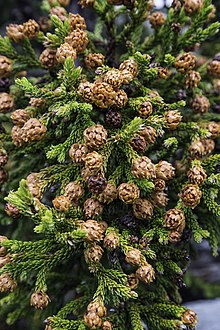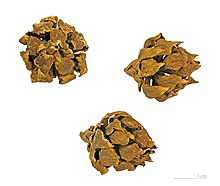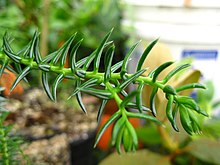bio.wikisort.org - Plant
Athrotaxis selaginoides is a species of Athrotaxis, endemic to Tasmania in Australia, where it grows at 400–1,120 m altitude. In its habitat in the mountains, snow in winter is very usual. It is often called King Billy Pine or King William Pine (believed to be in reference to William Lanne an Aboriginal man),[2] although it is not a true pine.[3][1]


Description
It is an evergreen coniferous tree growing to 20–30 m tall, with a trunk up to 1.5 m diameter. The leaves are claw-like, 7–18 mm long and 3–4 mm broad, arranged spirally on the shoots. The seed cones are globose, 15–30 mm diameter, with 20–30 spirally-arranged scales; they are mature about six months after pollination. The pollen cones are 4–5 mm long.[3]
Decline
The main cause of past decline has been fire, with about one third of its habitat burnt in the twentieth century. Like the other two Athrotaxis species, A. selaginoides is sensitive to fire. Another cause of past decline has been logging. The overall decline is estimated to be about 40% over the last 200 years. This is within the three generation time limit where one generation is estimated to be at least 100 years. Although 84% of forests are now in protected areas, fires still are a potential hazard. Tasmanian government policy precludes logging of this species in and outside these protected areas.[1]
Cultivation
Examples of the species can be viewed at The Tasmanian Arboretum. Away from its native range, it is occasionally cultivated as an ornamental tree in northwestern Europe.[4] It succeeds in Scotland where it receives the necessary rainfalls for its good growth[5] and produces fertile seeds there.[6]
References
- Farjon, A. (2013). "Athrotaxis selaginoides". IUCN Red List of Threatened Species. 2013: e.T32055A2810057. doi:10.2305/IUCN.UK.2013-1.RLTS.T32055A2810057.en. Retrieved 16 November 2021.
- "Native Conifers of Tasmania". Parks and Wildlife Service Tasmania. 17 July 2008. Retrieved 9 August 2011.
- Farjon, A. (2005). Monograph of Cupressaceae and Sciadopitys. Royal Botanic Gardens, Kew. ISBN 1-84246-068-4
- Mitchell, A. F. (1974). A Field Guide to the Trees of Britain and Northern Europe. Collins ISBN 0-00-212035-6
- Mitchell. A. F. Conifers in the British Isles. HMSO 1975 ISBN 0-11-710012-9. A bit out of date (first published in 1972), but an excellent guide to how well the various species of conifers grow in Britain giving locations of trees.
- Huxley. A. The New RHS Dictionary of Gardening. 1992. MacMillan Press 1992 ISBN 0-333-47494-5. Excellent and very comprehensive, though it contains a number of silly mistakes. Readable yet also very detailed.
На других языках
- [en] Athrotaxis selaginoides
[es] Athrotaxis selaginoides
Athrotaxis selaginoides, el cedro del rey Guillermo,[1] es una especie arbórea de la familia de las Cupresáceas, endémica de Tasmania en Australia. Allí crece a 400–1.120 m de altitud. En su hábitat en las montañas la nieve en invierno es muy usual. Con frecuencia se le llama Pino del Rey Guillermo, sin embargo no es un pino.[2][3]Другой контент может иметь иную лицензию. Перед использованием материалов сайта WikiSort.org внимательно изучите правила лицензирования конкретных элементов наполнения сайта.
WikiSort.org - проект по пересортировке и дополнению контента Википедии

